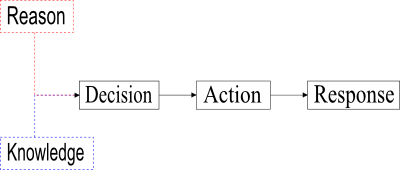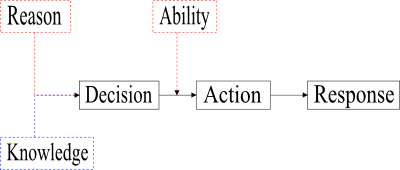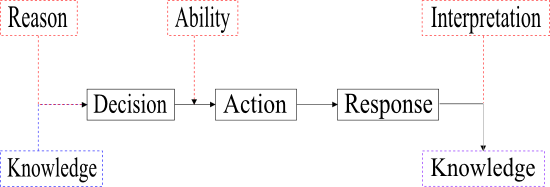Let us visualize the DAR model as follows:

Decisions lead to actions, which lead to the response.
When the player makes a decision, that decision happens because of some information. The player applies their own reason to various knowledge that they have in order to arrive at a particular decision. Thus, the combination of knowledge and the player's reason combine to create the decision, as shown here:

Given a specific decision, the player must now carry out that decision; they must take action. Action is informed by the decision of course, but it is also informed by the player's ability to effectively communicate that decision to the game. You can know all you can about how to pass though a Mario level, but that doesn't mean that you can do it:

Only the game's design informs a response. For now, let us assume that this is a black box: the player does something, and a response happens. It is now upon the player to interpret this response.
The important question, and the one that is vital to understanding the interactive loop, is this: what is gained by this interpretation for the player? Simply put: knowledge. It could be, depending on the element in question, something as simple as updating the position of the other entities in the world, or it could be some valuable insight on what happens when two entities interact in some way.
Knowledge is an important reward for a reason that you may have already guessed. But first, let's diagram this:

What we have is a feedback loop. Knowledge both fuels the system and is its output. Note that the response need not be only knowledge; some elements can provide other responses. But knowledge is what makes this feedback loop work. In essence, the player started this element knowing some things (potentially nothing), applied his reason to them, took action, and discovered something.
Let us define the Interactive Loop element as a game element that provides significant knowledge that will be of value to how the player reasons later on, possibly to the point of being vital to the player's later success. The idea is that the significant knowledge feeds into either this same element again (as when one is playing a game like Asteroids or Defender) or into a new element that the player may or may not have encountered previously.
Even so, it is very important to note something about the diagram. The three red boxes represent things beyond the game designer's control. A game designer can determine what decisions are possible (and not possible), what actions are available, and what the response to these will be. A designer cannot determine what the player's reason is, what the player's ability is, and what they interpret from that response. As such, the game designer can never be 100% assurred that the player has received the appropriate knowledge that a particular response is intended to evoke, because the player may have misinterpreted that knowledge.
So, what do we have now? We have the DAR model, which represents what the game defines. Now, we have the RAI model, which respresents how the player interacts and responds to the game. And we have a cross-connecting piece between them, which is the player's knowledge, which can be built up over time from prior game elements to inform the player's decisions.
We'll talk more about the RAI model in future issues.
No comments:
Post a Comment